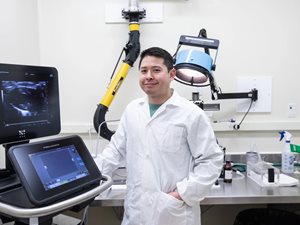People with diabetes are twice as likely than others to develop cardiovascular disease, yet many individuals are unaware of their increased risk.
The memory of how close she came to leaving her children alone in the world still makes Mafaz Ismail, 55, choke up slightly when she describes what she calls the ‘scary wake-up call’ that struck her in late May 2023. That’s when Ismail, a single mother of two adult children, learned that the type 2 diabetes (T2D) she’d lived with for decades had led to a 90 percent blockage in three of her coronary arteries.
People with diabetes are twice as likely than others to develop cardiovascular disease, with women at a higher risk of the artery-narrowing atherosclerosis Ismail was diagnosed with.
Yet despite a strong family history of T2D, until just a few months earlier, Ismail had never been properly informed how powerfully the condition increases the risk of heart and circulatory problems. “I didn’t make the connection that it’s really a fast ticket to cardiovascular diseases,” Ismail says.
And Ismail, previously an assistant to the former UAE Health Minister in Dubai, is in good company. In a 2020 study of 12,695 people living with T2D in 133 countries, only one in six were aware that they were at a high risk of cardiovascular disease, even though 28 percent had already experienced a cardiac event of some kind.
Fortunately, the Vancouver woman’s medical team recognized that the vague symptoms she’d been experiencing could be heart related. Accustomed to consistently working 14-hour days, Ismail had become mysteriously weak and fatigued. “I couldn’t easily get out of bed, and I literally couldn’t walk five steps. I didn’t know it was my heart,” Ismail says. “Thank goodness I was referred to my cardiologist.”
While coronary bypass surgery likely saved Ismail’s life, she’s determined to do everything possible to spare her daughter — who, like Ismail, was diagnosed with diabetes in her late teens — from a similar ordeal.
“At Diabetes Canada, we know that people living with diabetes first need to understand the risk of developing cardiovascular complications before they can manage those risks. But we also need to know that there is hope,” says Laura Syron, President & CEO of Diabetes Canada , who lives herself with type 2 diabetes. “We’re funding innovative research on the link between diabetes and cardiovascular health to help people living with diabetes live longer, healthier lives.”
In fact, Diabetes Canada-funded researchers are working on ways to prevent those living with diabetes from developing heart disease in the first place.

Ideally, that starts with testing for heart complications very early in the disease. “When someone is newly diagnosed with diabetes, we should already be proactively thinking about whether there are also heart conditions we should be managing at the same time,” emphasizes Dr. John Edward Ussher, professor in the Faculty of Pharmacy and Pharmaceutical Sciences at the University of Alberta in Edmonton and recipient of a Diabetes Canada research award.
Dr. Ussher is working on finding a way to intervene soon after someone is diagnosed with T2D to prevent another common cardiac complication. In recent years, “population data is showing that heart failure with preserved ejection fraction is more prevalent in people with diabetes,” he says. In this condition, the heart pumps normally, but is too stiff to relax well between pumps, and thus can’t properly fill with blood.
In recent years, studies have determined that, “people in the very early stages of diabetes often have defects in how their heart relaxes,” Ussher says. He and his colleagues have determined that this is linked to a malfunction in the way the heart uses fuel. Typically, it uses carbohydrates to power itself; however, “in someone with diabetes, the heart burns a lot more fat for energy, which is a less efficient fuel,” Ussher explains.
“There’s quite strong evidence that excess use of fat by the heart is a contributor to the problem of it not relaxing as well between pumps,” he adds. “The research we’re doing is focused on understanding how to restore the heart’s ability to burn carbohydrates and get people back to baseline.”
In the meantime, there are still ways of reducing the risk of heart attacks and strokes and improving quality of life for people living with T2D. Ismail took Dr. Ussher’s message to heart, and insisted her daughter ask her family doctor for a referral to a cardiologist.
She has enrolled in cardiac rehabilitation classes and is planning on finding heart-healthy cooking classes. She’s already much more mobile than she was prior to surgery.
“We deserve to be healthy, so we can enjoy life with our families,” she says. Once fully recovered, she’s looking forward to easing the load on her daughter, who’s working towards earning a master’s degree. “After the stress we went through together,” Ismail says, “I thank God I’m still alive to make it up to her.”
This story was created by Content Works, Postmedia’s commercial content division, on behalf of Diabetes Canada. Copyright Postmedia Network Inc.
Photo provided by: Jason Franson
Sponsored by Diabetes Canada 
Author: Wendy Haaf
Category Tags: Healthy Living, Community Spotlight, Impact Stories;
Region: National
Related Content

Newly diagnosed
A diabetes diagnosis can feel intimidating but just know we have the tools and resources you need to succeed.
Learn more About Newly diagnosed
Webinars
Gain knowledge on numerous diabetes-related topics from the comfort of your own home.
View webinars About Webinars
Tools and resources
Take charge of your health with tools and resources from Diabetes Canada.
Get started About Tools and resources